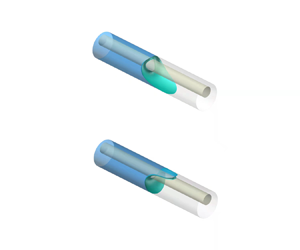Article contents
Eccentricity effect on horizontal capillary emptying
Published online by Cambridge University Press: 29 July 2022
Abstract

This paper theoretically studies the effect of eccentricity on the conditions of capillary emptying (determined by critical Bond number) in a horizontal annular tube in a downward gravity field. Experiments are conducted to compare with theoretical results. We find that non-horizontal eccentricity can lead to the occurrence of a re-entrant liquid-state transition (from liquid non-occlusion to liquid plug to liquid non-occlusion) with increasing Bond number, when the eccentricity (e) or inner-to-outer radius ratio (χ) is large enough, and the two liquid non-occlusion states correspond to different emptying mechanisms dominated by the gravity effect and the ‘wedge’ effect, respectively. Existence of the re-entrant transition is accompanied by occurrence of unconditional liquid non-occlusion at large enough or small enough contact angles regardless of Bond numbers. The critical Bond numbers at a contact angle γ for vertical upward eccentricity are equal to those at a contact angle 180° − γ for vertical downward eccentricity. In a parameter space (γ, e/(1 − χ)), the region with the re-entrant transition becomes larger with the eccentric angle varying from 0° (horizontal) to 90° (vertical). Optimization of geometrical parameters and inner and outer contact angles can lead to better effect of capillary emptying. This paper provides a very effective scheme for removing a liquid blockage from a capillary in optofluidics/microfluidics.
JFM classification
- Type
- JFM Papers
- Information
- Copyright
- © The Author(s), 2022. Published by Cambridge University Press
References
- 2
- Cited by



